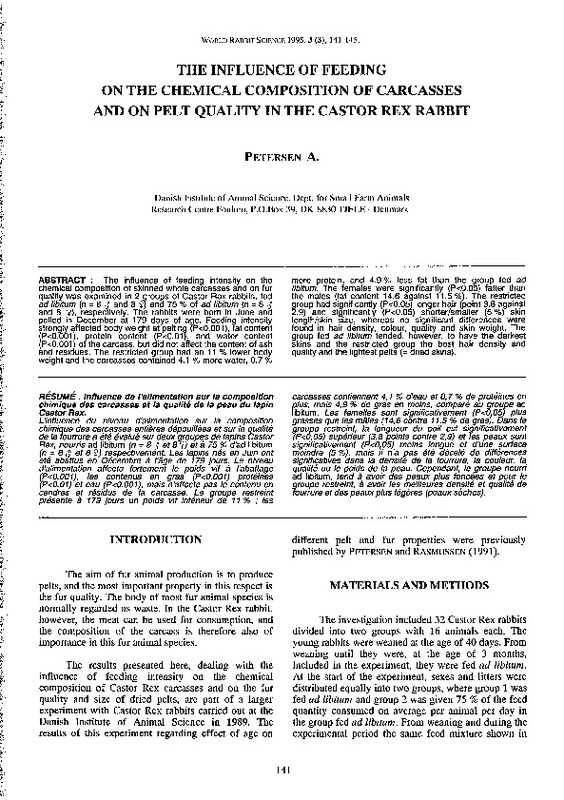JavaScript is disabled for your browser. Some features of this site may not work without it.
Buscar en RiuNet
Listar
Mi cuenta
Estadísticas
Ayuda RiuNet
Admin. UPV
THE INFLUENCE OF FEEDING ON THE CHEMICAL COMPOSITION OF CARCASSES AND ON PELT QUALITY IN THE CASTOR REX RABBIT
Mostrar el registro sencillo del ítem
Ficheros en el ítem
| dc.contributor.author | Petersen, A.
|
|
| dc.date.accessioned | 2011-03-21T14:15:38Z | |
| dc.date.available | 2011-03-21T14:15:38Z | |
| dc.date.issued | 1995 | |
| dc.identifier.issn | 1257-5011 | |
| dc.identifier.uri | http://hdl.handle.net/10251/10507 | |
| dc.description.abstract | [EN] The influence of feeding intensity on the chemical composition of skinned whole carcasses and on fur quality was examinad in 2 groups of Castor Rex rabbits, fed ad libitum (n = 8 ¿ and 8 <¡>¡ and 75 % of ad libitum (n = 8 ¿ and 8 <j>), respectively. The rabbits were born in June and pelted in December at 179 days of age. Feeding intensity strongly affected body weight at pelting (P<0.001). fat co. ntent (P<O.OOU, protein content (P<0.01 ), and water content (P<0.001 of the carcass, but did not affect the content of ash and resi ues. The restricted group had an 11 % lower body weight and the carcasses contained 4.1 % more water, O. 7 % more protein, and 4.9 % less fat than the group fed ad libitum. The females were significantly (P<0.05) fatter than the males (fat content 14.6 against 11.5 %). The restricted group had significantly (P<0.05) longer hair (point 3.8 against 2.9) and significantly (P<0.05) stiorter/smaller (5 %) skin length/skin size, whereas no significant differences were found in hair density, colour, quality and skin weight. The group fed ad libitum tended, however, to have the darkest skins and the restricted group the best hair density and quality and the lightest pelts (= dried skins). | es_ES |
| dc.description.abstract | [FR] L 'influence du niveau d'alimentation sur la composition chimique des carcasses entieres dépouillées et sur la qualité de la fourrure a été évalué sur deux g_roupes de lapins Castor Rex, nourris ad libitum (n = 8 ¿ et 8 <j>) et a 75 % d'ad libitum (n = 8 ¿ et 8 <j>) respectivement. Les lapins nés en Juin ont été abattus en Décembre a f'age de 179 jours. Le niveau d'alimentation affecte fortement le poids vif a f'abattage (P<0.001), les contenus en gras (P<0.001) protéines (P<0.01) et eau (P<0.001), mais n'affecte pas le contenu en cendres et résidus de la carcasse. Le groupe restreint présente a 179 jours un poids vif inférieur de 11 % ; les carcasses contiennent 4, 1 % d'eau et O, 7 % de protéines en plus, mais 4,9 % de gras en moins, comparé au gro~e ad libitum. Les feme/les sont significativement (P<0,05 plus grasses que les males (14,6 contre 11,5 % de gras). ans le groupe restreint, la longueur du poi/ est significativement (P<0,05) supérieur (3,8 points contre 2,9) et Tes peaux sont significativement (P<0,05) moins longue et d'une surface moindre (5 %), mais il n'a pas été aécelé de différences significatives dans la densité de la fourrure, la couleur, la qualité ou le poids de la peau. Cependant, le JJroupe nourri ad libitum, tend a avoir des peaux plus foncees et pour le groupe restreint, a avoir les meilleures densité et qualité de 1ourrure et des peaux plus légeres (peaux saches). | |
| dc.language | Inglés | es_ES |
| dc.publisher | World Rabbit Science. ICTA. UPV | es_ES |
| dc.relation.ispartof | World Rabbit Science | |
| dc.rights | Reserva de todos los derechos | es_ES |
| dc.title | THE INFLUENCE OF FEEDING ON THE CHEMICAL COMPOSITION OF CARCASSES AND ON PELT QUALITY IN THE CASTOR REX RABBIT | es_ES |
| dc.type | Artículo | es_ES |
| dc.date.updated | 2011-03-21T14:00:38Z | |
| dc.identifier.doi | 10.4995/wrs.1995.253 | |
| dc.rights.accessRights | Abierto | es_ES |
| dc.description.bibliographicCitation | Petersen, A. (1995). THE INFLUENCE OF FEEDING ON THE CHEMICAL COMPOSITION OF CARCASSES AND ON PELT QUALITY IN THE CASTOR REX RABBIT. World Rabbit Science. 3(3). https://doi.org/10.4995/wrs.1995.253 | es_ES |
| dc.description.accrualMethod | SWORD | es_ES |
| dc.relation.publisherversion | https://doi.org/10.4995/wrs.1995.253 | |
| dc.description.volume | 3 | |
| dc.description.issue | 3 | |
| dc.identifier.eissn | 1989-8886 | es_ES |








